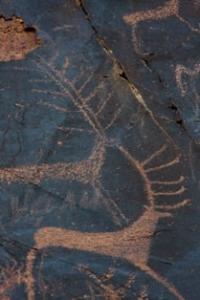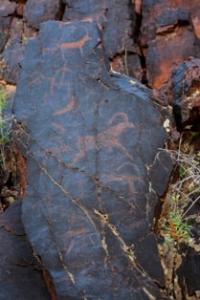You are here
Petroglyphs of Gabayevka.


Tours on petroglyphs of Kazakhstan.
“One is the way - the way of truth, everything else is not the way"
Book of the Avesta.
Individual tours in Kazakhstan.
The gorge with petroglyphs is located 27 km northeast of the village of Burnoe, 3 km southwest of the absolute mark of 1324 meters above sea level. This is the highest point of the southeastern end of the ridge. Karatau.
The gorge is located 6 - 8 kilometers northeast of the nearest settlement - the village of Gabayevka. It has a zigzag shape. A stream flows along the bottom of the gorge. Rock outcrops are slabs of siltstone-sandstone slate.
Petroglyphs are applied only to those of them that are distinguished by a strong panization. The main cluster of engravings is located near the nightmare on the slopes of the mountains. The plates with engravings were counted from the bottom of the rocks at the stream up the slope. In terms of plot, these images, like many other Karatau petroglyphs, are diverse.
Goats, argali, camels, bulls, horses, dogs, people, including those armed with clubs, bows, quivers, are carved on the rocks. There are also complex multi-figure compositions. On one of the slabs in the upper part are the figures of three archers.
Eight people holding hands are carved in the bottom row. They form a kind of round dance. To their left is a warrior armed with a club. A multi-figure composition is carved on another plate. Dogs, goats, camels, a chariot drawn by two horses are depicted, one of the horses is led by a man.
Repeatedly among the engravings there are images of broken lines, possibly snakes are carved. Both in terms of plot and stylistically, these engravings are closest to the petroglyphs of the lower layer of the tracts Arpausen and Koybagar.
Coincidences are expressed not only in the fact that the same animals are depicted (goats, bulls, camels), but also in the construction of compositions: these are camels driven by horses, chariots drawn by horses, archers hunting goats with dogs, a scene of dogs driving goats, point-shaped signs.
These images are stylistically close to other Karatau petroglyphs. As in ur. Arpauzen, in the engraving of Gabaevka the same method is encountered - the flight of the arrow is indicated in the form of a stretching straight line from a bow to a wounded animal or person.
Characteristically, people are depicted with arms apart, often with an underlined sign of gender. A number of features are related by these engravings with well-known images from Ur. Saymaly tash. These are figures of people facing each other, with their hands raised up, images of spectacle-shaped signs. In the engraving of Gabayevka, occasionally there are figures of animals, especially bulls and goats, made in the “bitriangular style”.
In general, this stylistic technique of conveying animal figures is not typical of Karatau petroglyphs and its presence in Gabayevka is most likely due to the fact that this complex is located closer to Saimaly-tash than others.
Although most of the images comprise the oldest stratum, not all petroglyphs are made in the same era. The palimpsests and the different color of the patina in individual engravings indicate that they were carved for a long time.
Many of the petroglyphs are poorly preserved, and it is almost impossible to distinguish animal figures. Most of the images are made carelessly and roughly, but individual compositions are distinguished by thinness of lines, animal figures are elegant and light.
The bulk of the petroglyphs is made by silhouette embossing, but there are also some contour images. The embossment is mainly large-dot, sometimes small-dot with a ground image plane. Large images are few. Basically, the sizes of animals are from 5 to 40 cm.
The relatively small sizes of the drawings are explained by the fact that in this tract there are no such large even plates with frequent patinization, as in Arpausen.
Authority:
The book "Petroglyphs of the Karatau ridge", authors M.K. Kadyrbaev, A.N. Maryashev.







